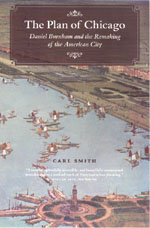An excerpt from
The Plan of Chicago
Daniel Burnham and the Remaking of the American City
Carl Smith
Introduction
The Plan of Chicago of 1909, more familiarly known as the Burnham Plan—after its principal author, architect and city planner Daniel H. Burnham—is one of the most fascinating and significant documents in the history of urban planning. Its fascination arises from the imaginative and visual appeal of its stirring prose and stunning illustrations, which combine to persuade the reader of the merit of its ideas. Burnham and his collaborators in the Commercial Club of Chicago, whose membership consisted of the city’s leading businessmen, contended beyond any uncertainty that boisterous Chicago required major alterations and that the creation of a finer city was within reach. The Plan’s significance rests in the fact that it helped convince so many people at the time and since, including some of its critics, of the truth of this contention.
While the Plan exemplifies the enduring aspiration of elite members of urban societies to make their cities grander and better organized, it also reflects the circumstances of a particular historical moment. The nineteenth century was the age of urbanization and industrialization, especially in the United States and western Europe. Between 1800 and 1900, the proportion of the American population living in urban areas (defined modestly in the federal census as places with 2,500 or more residents) ascended dizzily from just over 3 to almost 40 percent (the total population meanwhile went from 5,308,483 to 76,212,168). The country’s leading city, New York, exploded in this period from 60,515 to 3,437,202 (or over 4.5 percent of the entire nation), and by 1900 there were thirty-eight places with more than one hundred thousand residents. America’s most remarkable urban phenomenon, however, was Chicago. In 1830 it was a tiny settlement of perhaps one hundred people. A decade later it had 4,470 inhabitants, making Chicago the ninety-second biggest city in the country. By 1890 the number was 1,099,850, and it had moved up ninety places. By 1910, the year after the Plan of Chicago was published, the count was 2,185,283.
It is hard to appreciate in retrospect how provisional and roughedged turn-of-the-century Chicago remained, despite the fact that its economic and social base, as well as many of its physical features, were well established. While it could (and certainly did) boast of numerous impressive cultural institutions and its recent triumph with the World’s Columbian Exposition of 1893, Chicago was still an unruly place. Much of the cityscape was filthy and ugly, smoke pollution and faulty sanitation were unpleasant and unhealthy hazards, freight and passenger movement through the downtown was slow and inconvenient, a wide swath of railroad tracks isolated much of the city south of the river (including its commercial center) from the lakefront, and many streets were unpaved. A large number of working people lived amid marginal and sometimes desperate circumstances, so that eruptions of class antagonism and labor violence, though always unwelcome, were rarely unexpected. Astonished by the city, the fair, and the contrasts within and between them, the historian and cultural analyst Henry Adams famously observed, “Chicago asked in 1893 for the first time the question whether the American people knew where they were driving.”
The Plan of Chicago tried to answer this question, at least as far as cities were concerned. In so doing, it takes its place alongside other contemporary attempts to understand and improve Chicago. To name just two examples, Upton Sinclair’s The Jungle appeared only three years before the Plan, Jane Addams’s Twenty Years at Hull-House the year after. While their assessments of Chicago and their recommendations for reforming it were strikingly different from the Plan, the authors of all three books were confronting a similar group of concerns. Was it possible not only to determine the direction of urban experience, but also to make a major correction? More specifically, could cities be transformed into more orderly, beautiful, and humane settings without stifling the energies that propelled them? Might economic interests, the public good, and personal needs be reconciled? And could Chicago even become not just equal but superior to any other great city of the world, past or present?
The Plan of Chicago’s answer to all of these questions is a selfassured yes. Its ambitious proposals and its peremptory confidence in them are characteristic of the belief of civic-minded businessmen during the Progressive era in the necessity of redeeming American cities and their ability to accomplish this through rational reform. The Plan would not have been possible without the aggressive participation of the Commercial Club, whose vision of Chicago it unapologetically conveys, but the club would not have undertaken this project and the Plan certainly would not have anything like its prominence and authority without the full force of Daniel Burnham’s experience, wisdom, imagination, vigor, resolve, and charisma. The Plan discloses, however, the Commercial Club’s and Burnham’s blind spots as well as their insights, their conservatism as well as their grasp of modernity, their personal presumption as well as their faith in their city. Here, too, the Plan of Chicago is a reflection of its times and its origins, which no individuals, no matter how forward-looking, can transcend.
Chapter One
Planning before the Plan
The Plan of Chicago establishes its authoritative tone and announces its ruling assumptions in its opening pages. Urbanization, the Plan declares, is a defining condition of modernity. The current growth of cities was unprecedented, as was the increase in wealth and the advance of democracy. But “the formless growth of the city,” which had produced overcrowding and congestion, was “neither economical nor satisfactory.” As a result, the Plan explains, “practical men of affairs are turning their attention to working out the means whereby the city may be made an efficient instrument for providing all its people with the best possible conditions of living.” As for Chicago, its sudden emergence as a major metropolis was merely a prelude to its seizing its rightful place as the preeminent city of America and the world. It could only attain that position, however, if it exercised the vision and will required to discipline and direct the powerful but disparate physical and social energies that, having created this prodigious city, now threatened its undoing. Chicago’s spectacular development had resulted in “the chaos incident to rapid growth, and especially to the influx of people of many nationalities without common traditions or habits of life.”
 This map appears on the first page of chapter 3 of the Plan of Chicago. It demonstrates Chicago’s “location with regard to the seven central states”—that is, Ohio, Indiana, Michigan, Missouri, Iowa, Minnesota, and Wisconsin, not to mention the rest of Illinois. The radiating lines, colored in red in the Plan, emphasize how well connected Chicago was to smaller cities in the region. Chicago Historical Society (ICHi-39070_3e). • Larger image
|
|
But was it true that Chicago had evolved without any plan? In fact, by 1909 it had been the site of many plans. While the city always attracted opportunists focused only on immediate gain, as early as the 1830s it was being fashioned by people who consistently looked ahead. This hardly means that they did not often pursue very short term— and shortsighted—goals. But they consistently and actively attempted to create what was by their lights a better city, in the belief, shared by the authors of the Plan, that improving Chicago as a whole would benefit everyone who lived within it.
The place and the times rewarded Chicagoans’ efforts to grow their own and their city’s fortunes. Modern Chicago owes its origins to its location at the southwestern edge of the Great Lakes near a convenient portage to the Mississippi Valley and the heart of the continent. The most distinctive feature of the setting was, paradoxically, its lack of distinctive features. The level prairie that stretched in all directions away from the lake invited the most ambitious conceptions by offering few obvious natural obstacles to their realization. The prairie and the lake, the Plan observes, “each immeasurable by the senses,” dictated the scale of possibility in Chicago. “Whatever man undertakes here,” it continues, “should be either actually or seemingly without limit.” While European explorers recognized the area’s promise as early as the 1670s, the fulfillment of its potential had to wait for the right historical moment. This arrived in the antebellum decades with the onset of the industrial, transportation, and communications revolutions in the United States.
These developments animated an increasingly networked national and international free-market economy, a jump in both immigration from abroad and population mobility within the nation, and an ethos of hyperbolic boosterism, the local form of the national rhetoric of manifest destiny. Chicago was home to nearly thirty thousand people by 1850 and to ten times that number only twenty years later. After the Great Fire of 1871 incinerated close to a third of the city, including the commercial downtown and most of the North Side, Chicago was speedily rebuilt, thanks to the irrepressible spirit of local residents and an infusion of capital from investors elsewhere who knew the country needed this great central marketplace. None of this happened smoothly. Considerable tumult, whether in the form of financial busts that alternated unpredictably with the booms or social and economic tensions that all too often erupted into violence, marked the city’s growth through the late nineteenth and early twentieth centuries.
 This is the third of several editions of this map of the devastation caused by the Great Chicago Fire of 1871 that were published by the R.P. Studley Company of St. Louis, with proceeds going to the victims of the fire. There were many different versions of this map. In this one, north is to the right. The fire’s point of origin, behind the Near West Side cottage of Catherine and Patrick O’Leary, is located at the upper left-hand point. The map dramatically displays not only the extent of the destruction but also how the fire leaped the South and Main branches of the Chicago River as it moved north and east, destroying the downtown and most of the North Side. Chicago Historical Society (ICHi-14894). • Larger image |
Where was planning in all of this, or did the invisible hand of market forces take care of everything? In a noted address delivered in 1923 at the Field Museum to the Geographical Society of Chicago and appropriately titled “Chicago: A City of Destiny,” J. Paul Goode, professor of geography at the University of Chicago, argued that the advantages of the city’s location, and the local population’s ability to understand and exploit these advantages, made Chicago’s eminence inevitable. Thirty-two years later, Harold M. Mayer, another University of Chicago geography professor speaking under the same auspices, complicated Goode’s argument. Mayer began his lecture, “Chicago: City of Decisions,” by citing five deliberate actions that “have carried [Chicago] toward its destiny as the Metropolis of the Midwest.” These included the provision of the federal Land Ordinance of 1785 that dictated Chicago’s (and many other towns’) rectangular street grid, the building of Fort Dearborn near the mouth of the Chicago River in 1803, and the choice by railroads to make Chicago what historian William Cronon has called the “gateway city” between the industrializing East and the agricultural hinterland. Of interest here is that Mayer’s other two examples were the creation of the Plan of Chicago and “the decision to set up planning as a continuous operation in Chicago.”
Mayer stated that he picked these five decisions “more or less arbitrarily.” He claimed that he could have chosen any of a number of other examples. Among them were many of the developments he and his coauthor Richard C. Wade later described in Chicago: Growth of a Metropolis (1969). These included the cut in the sandbar that had impeded entrance to the Chicago River and the construction of a harbor at that entrance, both accomplished by 1833; the expulsion of the Native American population shortly after; the greatly anticipated and much-delayed completion of the Illinois and Michigan Canal, which was finally in operation by 1848; the raising of the city’s grade and the construction of a comprehensive waterworks, both of which began in the 1850s; the establishment of the South, West, and Lincoln parks and the boulevard system that connected them, starting in the late 1860s; and the successful reversal of the flow of the Chicago River, after several earlier attempts, during the 1890s. All of these entailed planning in that they were long-term coordinated efforts usually involving direct or indirect public participation, approval, and financing. Chicago was also the site of several large scale privately funded planning initiatives, among them the opening of the Union Stock Yard in 1865, the building of the model town of Pullman in the 1880s, and the creation of the Central Manufacturing District in 1905. As the Plan said of its own purpose, the aim of all of these was “to anticipate the needs of the future as well as to provide for the necessities of the present.”
 Chicago’s swampy and low-lying setting led to its being literally raised several feet. Some buildings were not only lifted but also moved to different locations. In this view of Lake Street in 1855, which building contractors used as an advertisement, the work goes on in the background as the cosmopolitan passersby seem to pay little mind. Edward Mendel, Chicago Historical Society (ICHi-00698). • Larger image |
In ways that transcend any individual example, the planning idea is deeply ingrained in the nature and character of Chicago. The city’s lack of a long history, at least from the point of view of those not of Native American ancestry, both invited and demanded planning. One of the things that distinguished Chicago from the other leading American cities that, with the exception of New York, it surpassed in population by 1890 was the comparative brevity of its past. What history Chicago did possess its residents commonly ignored because they felt little connection to it. Through the nineteenth century, Chicago’s population consisted overwhelmingly of those who, if not from somewhere else themselves, were children of parents born and raised in other places. Commonly this elsewhere was a different and distant country. And if members of the city’s commercial and social elite were largely native born, they, too, had mostly come to Chicago from other parts of the United States.
Even in the early twentieth century, when the Plan of Chicago appeared, self-made men constituted the bulk of this elite, though more and more the sons of such economic pioneers were taking positions of leadership. For much of the city’s population, moving to Chicago and allying oneself with its future had been central to their own personal plans for success. Indeed, few places were so speculatively oriented. It is no coincidence that Chicagoans created the modern commodities market, in the form of the Chicago Board of Trade, where the future itself is bought and sold. Nor was it out of the city’s character that real estate developers purchased property in sparsely settled areas in anticipation of the growth that was sure to make the investment pay.
Nowhere else in the United States did booster rhetoric rise to such brassy grandiloquence. Of the countless speeches and tracts that boomed Chicago’s prospects, few outstripped the hyperbolic optimism of the thick volume Chicago: Past, Present, Future, subtitled Relations to the Great Interior, and to the Continent, first published in 1868 by John S. Wright. Wright arrived from western Massachusetts in 1832 at the age of seventeen. Before he was twenty-one, he made a fortune in real estate speculation. Wright prepared a census and one of the earliest maps of Chicago, and he constructed at his own expense the town’s first public school. Wright’s real estate profits evaporated in the Panic of 1837 (he lost another fortune twenty years later investing in a new kind of reaper), but his faith in the city’s prospects never wavered. Well before J. Paul Goode’s address to the Geographical Society, Wright contended that the natural creation had been planned with Chicago’s greatness in mind. “It is clear as sunlight,” he proclaims, “that for Illinois, Wisconsin, Minnesota, Iowa, North Missouri, and part of Indiana and Michigan, this city must be the emporium.” Of all America’s new western cities, Wright likewise declares, Chicago “is most certain to grow.” Speaking of the city’s nondescript topography, Wright adds, “There never was a site more perfectly adapted by nature for a great commercial and manufacturing city, than this.”
One could dismiss all of this as bombast, except for the fact that it was true. In 1861 Wright reportedly predicted that within a quarter of a century the city’s population would reach 1 million. He was off by only four years. Wright’s main point was that, whatever the momentary setbacks, Chicago’s progress was irresistible. The future, the most valuable commodity in Chicago, would be bigger and better, and it would belong to those who most fully understood the potential that lay in the factors that Goode listed and who then knew how to command Chicago’s promise with the kind of decisions that Mayer described. In Chicago, Mark Twain writes in Life on the Mississippi (1883), “they are always rubbing the lamp, and fetching up the genii, and contriving and achieving new impossibilities.” For the occasional visitor, Twain explains, Chicago was always a “novelty,” since “she is never the Chicago you saw when you passed through the last time.”
Well before the Plan of Chicago was published, there were also those who anticipated its assertion that in their haste Chicagoans had built all too carelessly and with insufficient planning. Legendary landscape architect Frederick Law Olmsted, reflecting on the Great Chicago Fire in the Nation shortly after the conflagration occurred, was only one of several observers who attributed the extent of the damage to hurried and sloppy building. Olmsted—who had recently designed the South Side’s Jackson Park and Washington Park, as well as the elegant suburb of Riverside—would twenty years later be one of Plan author Daniel Burnham’s chief collaborators on the World’s Columbian Exposition of 1893. Chicago’s “weakness for ‘big things,’” its desire “to think that it was outbuilding New York,” Olmsted wrote, did not directly cause but certainly invited the disaster. The editors of the Chicago Inter-Ocean at the time agreed, stating that the fire revealed that the city’s “paramount need was harness, self-restraint, the temperance which comes from experience.” None of these qualities thrived in Chicago.
At the turn of the twentieth century, numerous observers criticized the apparent governing spirit of Chicago and other cities for thinking of planning, if at all, merely as a matter of expanding the urban infrastructure in ways that would attract and support yet more private commercial investment. It was bad policy, these critics maintained, to entrust the future to real estate developers, project engineers, and most public officials, who rarely lifted their eyes from the matter right at hand. In too many instances, the highest concern of such people was how quickly and cheaply they could get a particular project done, not how long it would last or how it related to the city as a whole. Though by the 1880s Chicago was becoming famous for its architecture, the most skilled designers were responsible only for a limited number of buildings and did not pay a great deal of attention to the larger context as they worked on individual structures.
Some thoughtful Chicagoans complained that their fellow citizens measured civic achievement only in quantitative rather than qualitative terms, and rarely with anything but their own personal welfare in mind. As a result, Chicago suffered from being a place where all too many people came to work and invest rather than to live, and this showed in the city they had built. One of the city’s most thoughtful and perceptive social observers was journalist and novelist Henry Blake Fuller, who was actually born and raised in the city but who never made peace with its booster ethos and imperious entrepreneurial spirit. Commenting on the built environment of Chicago in an article on the city in the Atlantic Monthly in 1897, Fuller noted with regret, “Possessed of a single sheet of paper, we have set down our crude, hasty, mistaken sketch upon it, and we shall have the odds decidedly against us in any attempt to work over this sketch, made on the one surface at our disposal, into the tasteful and finished picture that we may be hoping finally to produce.” In Fuller’s novel With the Procession (1895), a civic-minded group aptly named the Consolation Club meets to consider the affairs of their “vast and sudden municipality.” One of its members remarks sadly, “This town of ours labors under one peculiar disadvantage: it is the only great city in the world to which all its citizens have come for the one common, avowed object of making money.”
The Plan of Chicago combines familiar booster rhetoric with the
reservations expressed by Olmsted, Fuller, and others. On the one
hand, it contains passages that John S. Wright could have written, as
when it flatly states, “Chicago is now facing the momentous fact that
fifty years hence, when the children of to-day are at the height of
their power and influence, this city will be larger than London: that
is, larger than any existing city.” On the other hand, it rejects the idea
that the city’s success could or should be evaluated in terms of numbers
alone, or that the future would take care of itself. While Chicago’s
growth had exceeded the most optimistic projections, it was
time to rethink some basic conceptions of civic success. Fortunately,
the Plan states, “the people of Chicago have ceased to be impressed by
rapid growth or the great size of the city. What they insist [on] asking
now is, How are we living?” The answer to that question was not
reassuring, and the only proper course of action, the Plan asserts, was
to prove Fuller’s pessimism wrong and triumphantly remake the city.
![]()
Copyright notice: Excerpt from pages xv-xvii and pages 1–10 of The Plan of Chicago: Daniel Burnham and the Remaking of the American City by Carl Smith, published by the University of Chicago Press. ©2006 by The University of Chicago. All rights reserved. This text may be used and shared in accordance with the fair-use provisions of U.S. copyright law, and it may be archived and redistributed in electronic form, provided that this entire notice, including copyright information, is carried and provided that the University of Chicago Press is notified and no fee is charged for access. Archiving, redistribution, or republication of this text on other terms, in any medium, requires the consent of the University of Chicago Press. (Footnotes and other references included in the book may have been removed from this online version of the text.)
Carl Smith
The Plan of Chicago: Daniel Burnham and the Remaking of the American City
©2006, 202 pages, 62 halftones, 6 maps
For information on purchasing the book—from bookstores or here online—please go to the webpage for The Plan of Chicago.
See also:
- Burnham of Chicago: Architect and Planner by Thomas S. Hines
- More books in the Chicago Visions and Revisions series
- Our books about Chicago
- Our catalog of architecture titles
- Other excerpts and online essays from University of Chicago Press titles
- Sign up for e-mail notification of new books in this and other subjects
- Read the Chicago Blog
